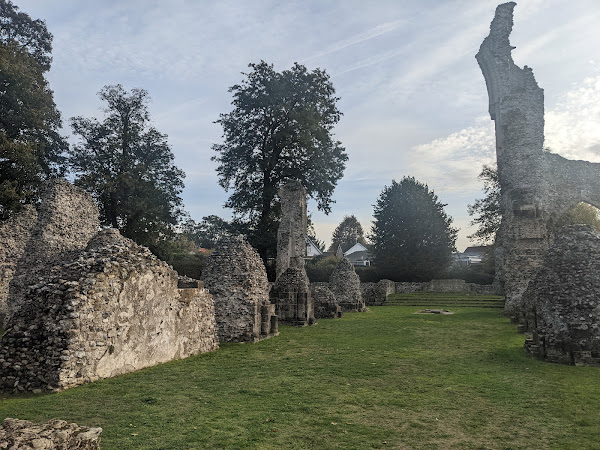In an effort to continue targeting the eastern-most event, I decided that today would be the day I finally attended Thetford parkrun, having passed the town quite frequently while I was visiting the 10 or 11 East Norfolk events, including the 4 Norwich events; Norwich, Catton, Sloughbottom, and Colney Lane parkruns.
The area
Thetford has played several important roles throughout history, providing flint for use in tools since 2000BC, which saw the town grow to approximately the sixth largest town in Britain in 1086. The town was impacted greatly by the dissolution of the monastaries, which resulted in severe squalor in the town, with attempts in he 1800s to restore the town ultimately failing. The town eventually saw growth again in the 1980s as a result of an agreement with the London Country Council to relocate Londoners.
Thetford Priory was one of the last casualties of the dissolution of the monastaries. Attempts by local politicians to repurpose the buildings owing to how severely the town's population relied upon it - predicting the poverty that lay ahead ultimately failed, and the building shut its doors for the last time in 1540.
The course
The route is run on a mixture of tarmac and grass, and is mostly flat, with only one minor rise. The course can be split into three smaller loops, each of which are covered twice; once around the first section, twice around the second section, twice around the third section, and once more around the first section.
Parking is available at the local Iceland supermarket. There are no public toilets, although the course is close to the town centre which has both public toilets and several places serving post-run refreshments, including the town market!
The run
As I arrived at the recommended car park ready for today's event, I was suprised to see a number of what looked like steam-powered tractors emerging from a building next to the car park, and driving into the car park. I would later find out that this was the last steam up of the traction engines of the Charles Burrell Museum.
It had been raining overnight before today's run, and the warm weather meant that there was a haze in the air for today's event - not ideal running conditions! The grass was long enough, and wet enough, to make running even more of a challenge, and so I deliberately took today's run slowly. As this was going to be a slower run, I also decided to walk the tarmac sections to avoid any unnecessary risk being placed on my recovering injuries!
Thank you to all of the wonderful volunteers today!
After the run
As the event takes place on the grounds of Thetford Priory, I took the opportunity to explore the ruins of the priory in closer detail.
The priory was founded in 1103, and was in use until the dissolution of the monestaries in 1540. Much of the gatehouse entrance is standing today, in much the same condition as at the time of its use, though the gatehouse itself was closed for repairs during my visit.
The Prior's lodging also remains standing, and gives an impression of what the complex would have looked like in its heyday.
By the time I had returned to the car park, the steam engines had drawn a sizable crowd, and two main engines were parked up, while many smaller engines (belonging to hobbyists) were also spread across the car park.
One of the larger engines was also providing rides around the immediate area.
To the eastern side of Thetford lies Castle Park - the site of Thetford Castle. Only the mound remains today, although it does offer fantastic views over Thetford and beyond to those who climb its 90 steps.
Many of the buildings throughout Thetford were constructed many hundreds of years ago, with examples such as the Bell Inn dating from at least the 1490s.
A short distance outside of the town itself, and just inside Thetford Forest lies Thetford Warren Lodge - the remains of a building used to raise and hunt rabbit for consumption locally, and for the rabbit's pelt, likely build by the monks who habbited Thetford Priory. This is the sister warren to the one I explored after Mildenhall Hub parkrun, though this one hasn't had benefits of restoration work.
As I was in the area, I decided to explore Thetford Forest again, having explored it previously when I attended Brandon Country Park parkrun. While the forest consists primarily of coniferous trees, there are many deciduous trees too, whose leaves were beginning to fall.
Links: Thor's Hammer | BBC News | Thor's Hammer | Ancient House | Results | Strava









